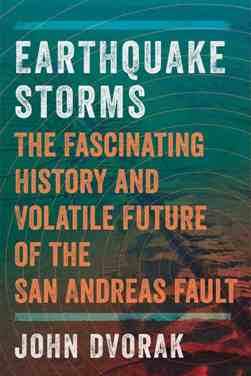
Ever since the devastating 1906 earthquake in San Francisco, the San Andreas fault—first recognised by Andrew Lawson in 1895—has been the world’s most famous geological fault. Yet despite its celebrity, there are hardly any good recent books about the fault for the non-specialist: perhaps only historian Philip Fradkin’s
Magnitude 8: Earthquakes and Life along the San Andreas Fault, which gives more space to the fault’s impact on Californian politics, economics and culture than to seismology.
Earthquake Storms, by California-trained geologist John Dvorak, is therefore a welcome addition. Its chief strength lies in combining the lives and personalities of key geologists and seismologists, such as Lawson, Charles Richter, John Tuzo Wilson and Kerry Sieh, with the theoretical essentials and practical details of their scientific work, so that the former really do illuminate the latter—notwithstanding the regrettable absence of a map of California or any seismological diagram. For example, we learn the inside story of the classic Edwardian photograph (reproduced in the book) of a woman, dressed in a dark ankle-length skirt and hat decorated with flowers, standing somewhat incongruously beside the ‘mole track’ ridge thrown up by the San Andreas fault as it ruptured 270 miles of northern California. The photo was taken by geologist Grove Karl Gilbert, a member of the 1906 earthquake commission; the woman is his lover Alice Eastwood, a leading botanist with a daredevil streak. Just weeks before, while her San Francisco apartment burned in the great fire started by the earthquake, Eastwood had twice scaled the iron banisters of the wrecked central staircase of the California Academy of Sciences so as to rescue her rare botanical collection from the sixth floor.
The book’s title is taken from geophysicist Amos Nur, who suggested in 2000 that one earthquake may trigger another, causing them to cluster together in ‘earthquake storms’. Several major earthquakes over a period of mere decades around 1200 BC were responsible for the destruction of western civilisation (Knossos, Mycenae, Troy, etc) in the eastern Mediterranean, argues Nur. The same pattern has been occurring in southwest China along the northern edge of the Tibetan plateau since the 1890s, says Dvorak. Might a seismic storm also occur in southern California in coming decades, following two puzzling Mojave Desert earthquakes in the 1990s? Conceivably. But given the mind-boggling complexity of California’s faults—700 of which have ruptured over 10,000 years—earthquake prediction is currently impossible, as Dvorak finally has to concede.
Reviewed by Andrew Robinson
EARTHQUAKE STORMS: THE FASCINATING HISTORY AND VOLATILE FUTURE OF THE SAN ANDREAS FAULT by JOHN DVORAK, 2014. Published by: Pegasus Books 254pp (hbk) ISBN: 9781605984957 List Price: $27.95. W: www.pegasusbooks.us